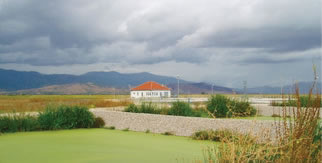
Environmental Science and Engineering
Evaluation of Chemical and Biological Indicators for Source Apportionment of Phosphorus in Table Rock Lake, on the Missouri-Arkansas Border
Publication Date: February 2006
Cooperating Institution: Washington University
Principal Investigator: Dan Giammar and Lars Angenant
Project Budget: $172,145
Project Identifier: WU-HT-03-00
DESCRIPTION
Preserving the water quality of freshwater lakes requires protection from excessive loading of the nutrients nitrogen and phosphorus. In many lakes, phosphorus is the limiting nutrient. Phosphorus inputs to lakes include both point and non-point sources. Phosphorus inputs from point sources can be regularly monitored and controlled at a single location, but phosphorus loadings from non-point sources are more difficult to quantify and control. Centralized wastewater treatment facilities are the largest potential point source, and non-point sources include decentralized wastewater treatment systems as well as agricultural and urban runoff. Although phosphorus is retained in the leach fields of properly functioning septic systems, phosphorus can be highly mobile from poorly functioning or non-functioning septic systems. Apportionment of phosphorus loadings to multiple sources is currently accomplished using a combination of direct measurements of point sources and estimations of non-point source contributions based on land use distributions. A complementary apportionment approach could involve the measurement of certain chemical and biological species as tracers. Useful tracers would be present in different sources with unique relative concentrations (source signatures), and useful tracers must also meet requirements regarding reproducibility, specificity to source type, and stability with respect to transport and degradation. The proposed project will evaluate the utility of select chemical and biological species for phosphorus source apportionment within the context of Table Rock Lake on the Missouri-Arkansas border.
The proposed project will evaluate three classes of potential tracers: 1) trace elements, 2) synthetic organic chemicals, and 3) biological species. Heavy metals and metalloids are the trace elements to be studied. A small set of prescription and non-prescription drugs that are amenable to analysis by high performance liquid chromatography are the synthetic organic chemicals of interest. Bacteriophages have been selected as the biological tracers of interest. The investigation will combine direct sampling of waters from potential phosphorus sources with sampling of surface waters likely to have been predominantly impacted by a single type of source (source-rich surface waters). Sampling activities will be performed in and around Table Rock Lake on the Missouri-Arkansas border. Population and development in the Table Rock Lake watershed have increased rapidly in the last two decades, and the lake was recently put on the Missouri list of impaired waters because of high phosphorus concentrations. The project will focus on four potential phosphorus sources: 1) centralized wastewater treatment plants, 2) decentralized wastewater treatment systems, 3) runoff of animal wastes from feeding operations or fields to which wastes were applied, and 4) runoff of inorganic phosphate fertilizers. Specific sources and sampling locations will be identified, and four sampling campaigns will be performed over the course of one year. The sampling and analysis activities will generate a large dataset that will be evaluated for data quality and analyzed to identify the most useful tracers.
The project will determine the utility of a set of potential chemical and biological tracers. The most useful tracers will be identified, and these tracers can have direct benefits to the management of Table Rock Lake by identifying the most significant sources of phosphorus to the lake. By working with the local non-profit corporation Table Rock Lake Water Quality, Inc., the project will have access to local expertise and the local community will have a conduit for accessing and applying the results of the project. More generally, the determination of useful tracers can provide a complementary approach to current source apportionment methods that are based on land use, and such an approach can have impacts far beyond the context of Table Rock Lake.

